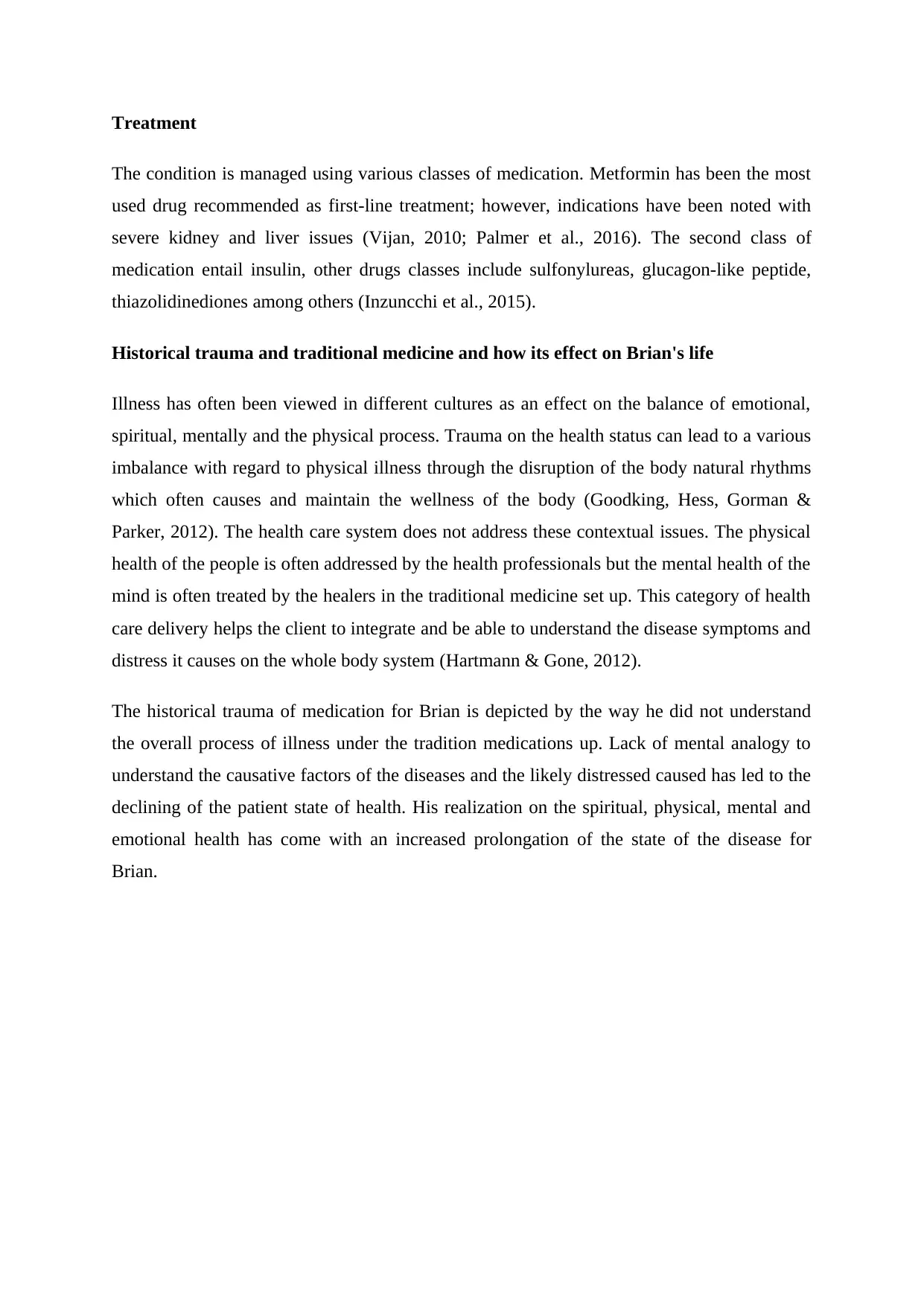Comprehensive Essay on Type 2 Diabetes: A Public Health Perspective
VerifiedAdded on 2023/01/19
|5
|1130
|76
Essay
AI Summary
This essay delves into the multifaceted nature of Type 2 diabetes, a long-term metabolic disorder characterized by high blood sugar levels, insulin resistance, and sometimes, insufficient insulin production. The essay explores the primary causes, including obesity, lack of exercise, and genetic predisposition, while also outlining the common symptoms such as frequent urination, increased thirst and hunger, and weight loss. Furthermore, the essay addresses preventive strategies, emphasizing the importance of proper nutrition, regular physical exercise, and, in some cases, medication like metformin. Finally, the essay discusses various treatment options, including medication classes like metformin, insulin, sulfonylureas, and other drugs, to manage the condition effectively. The essay also touches upon the historical trauma and traditional medicine and how it effects an individual's health.

Movie Review
University
Unit
Name
Tutor
Date
University
Unit
Name
Tutor
Date
Paraphrase This Document
Need a fresh take? Get an instant paraphrase of this document with our AI Paraphraser

Type II diabetes
Type II diabetes refers to a long term disorder of the metabolism which is associated with
high blood sugar, resistance to insulin and less common lack of insulin.
Causes
Type II diabetes occurs due to obesity and excess weight associated with lack of exercise
(Salih, 2014). At times some patients develop it genetically having more risks than others.
Type II diabetes account for 90% of diabetes cases, the underlying causes entail a
combination of lifestyle, genetic factors, obesity, and dietary factors. Other cases have been
attributed to increasing age, gender status and genealogy history (Melmed et al., 2015).
Signs and symptoms
The common classical symptoms of diabetes entail frequent urination; a state of polyuria,
increased thirsts leading to polydipsia, increased hunger reflecting polyphagia and weight
loss. Other symptoms entail blurred vision, fatigue neuropathy and vaginal infection among
women (Vijan, 2010). Symptoms often take longer to present and often require routine
testing. Among, persons diagnosed with type II diabetes, few often develop hyperosmolar
hyperglycaemic state which is associated with elevated blood sugar and lowered levels of
consciences and decreased blood pressure (Gardiner & Shoback, 2011).
Prevention
Type II diabetes can be delayed through prevention strategies such as proper nutrient and
deist coupled with regular physical exercise. Aggressive and intensive lifestyle strategies are
essential as they reduce the risks by half (Schellenberg et al., 2013). The beneficial effects of
exercise tend to occur regardless of the person weight status initial or other weight loss.
Dietary changes are essential with increased intake in high green leafy vegetables and
limitation of sugary drinks (Malik, Popkin, Bray, Després, 2010). In impaired glucose
tolerances, there is a need for a combination of diet, exercise, and intake of metformin drug
which decreases diabetes development risks (Salih, 2010).
Type II diabetes refers to a long term disorder of the metabolism which is associated with
high blood sugar, resistance to insulin and less common lack of insulin.
Causes
Type II diabetes occurs due to obesity and excess weight associated with lack of exercise
(Salih, 2014). At times some patients develop it genetically having more risks than others.
Type II diabetes account for 90% of diabetes cases, the underlying causes entail a
combination of lifestyle, genetic factors, obesity, and dietary factors. Other cases have been
attributed to increasing age, gender status and genealogy history (Melmed et al., 2015).
Signs and symptoms
The common classical symptoms of diabetes entail frequent urination; a state of polyuria,
increased thirsts leading to polydipsia, increased hunger reflecting polyphagia and weight
loss. Other symptoms entail blurred vision, fatigue neuropathy and vaginal infection among
women (Vijan, 2010). Symptoms often take longer to present and often require routine
testing. Among, persons diagnosed with type II diabetes, few often develop hyperosmolar
hyperglycaemic state which is associated with elevated blood sugar and lowered levels of
consciences and decreased blood pressure (Gardiner & Shoback, 2011).
Prevention
Type II diabetes can be delayed through prevention strategies such as proper nutrient and
deist coupled with regular physical exercise. Aggressive and intensive lifestyle strategies are
essential as they reduce the risks by half (Schellenberg et al., 2013). The beneficial effects of
exercise tend to occur regardless of the person weight status initial or other weight loss.
Dietary changes are essential with increased intake in high green leafy vegetables and
limitation of sugary drinks (Malik, Popkin, Bray, Després, 2010). In impaired glucose
tolerances, there is a need for a combination of diet, exercise, and intake of metformin drug
which decreases diabetes development risks (Salih, 2010).

Treatment
The condition is managed using various classes of medication. Metformin has been the most
used drug recommended as first-line treatment; however, indications have been noted with
severe kidney and liver issues (Vijan, 2010; Palmer et al., 2016). The second class of
medication entail insulin, other drugs classes include sulfonylureas, glucagon-like peptide,
thiazolidinediones among others (Inzuncchi et al., 2015).
Historical trauma and traditional medicine and how its effect on Brian's life
Illness has often been viewed in different cultures as an effect on the balance of emotional,
spiritual, mentally and the physical process. Trauma on the health status can lead to a various
imbalance with regard to physical illness through the disruption of the body natural rhythms
which often causes and maintain the wellness of the body (Goodking, Hess, Gorman &
Parker, 2012). The health care system does not address these contextual issues. The physical
health of the people is often addressed by the health professionals but the mental health of the
mind is often treated by the healers in the traditional medicine set up. This category of health
care delivery helps the client to integrate and be able to understand the disease symptoms and
distress it causes on the whole body system (Hartmann & Gone, 2012).
The historical trauma of medication for Brian is depicted by the way he did not understand
the overall process of illness under the tradition medications up. Lack of mental analogy to
understand the causative factors of the diseases and the likely distressed caused has led to the
declining of the patient state of health. His realization on the spiritual, physical, mental and
emotional health has come with an increased prolongation of the state of the disease for
Brian.
The condition is managed using various classes of medication. Metformin has been the most
used drug recommended as first-line treatment; however, indications have been noted with
severe kidney and liver issues (Vijan, 2010; Palmer et al., 2016). The second class of
medication entail insulin, other drugs classes include sulfonylureas, glucagon-like peptide,
thiazolidinediones among others (Inzuncchi et al., 2015).
Historical trauma and traditional medicine and how its effect on Brian's life
Illness has often been viewed in different cultures as an effect on the balance of emotional,
spiritual, mentally and the physical process. Trauma on the health status can lead to a various
imbalance with regard to physical illness through the disruption of the body natural rhythms
which often causes and maintain the wellness of the body (Goodking, Hess, Gorman &
Parker, 2012). The health care system does not address these contextual issues. The physical
health of the people is often addressed by the health professionals but the mental health of the
mind is often treated by the healers in the traditional medicine set up. This category of health
care delivery helps the client to integrate and be able to understand the disease symptoms and
distress it causes on the whole body system (Hartmann & Gone, 2012).
The historical trauma of medication for Brian is depicted by the way he did not understand
the overall process of illness under the tradition medications up. Lack of mental analogy to
understand the causative factors of the diseases and the likely distressed caused has led to the
declining of the patient state of health. His realization on the spiritual, physical, mental and
emotional health has come with an increased prolongation of the state of the disease for
Brian.
⊘ This is a preview!⊘
Do you want full access?
Subscribe today to unlock all pages.

Trusted by 1+ million students worldwide

References
Gardner, D.G. and Shoback, D., 2011. Hormones and Diabetes Mellitus. Greenspan’s Basic
and Clinical Endocrinology.
Goodkind, J.R., Hess, J.M., Gorman, B. and Parker, D.P., 2012. “We’re Still in a Struggle”
Diné Resilience, Survival, Historical Trauma, and Healing. Qualitative health research,
22(8), pp.1019-1036.
Hartmann, W.E. and Gone, J.P., 2014. American Indian historical trauma: Community
perspectives from two Great Plains medicine men. American Journal of Community
Psychology, 54(3-4), pp.274-288.
Inzucchi, S.E., Bergenstal, R.M., Buse, J.B., Diamant, M., Ferrannini, E., Nauck, M., Peters,
A.L., Tsapas, A., Wender, R. and Matthews, D.R., 2015. Management of hyperglycaemia in
type 2 diabetes, 2015: a patient-centred approach. Update to a position statement of the
American Diabetes Association and the European Association for the Study of Diabetes.
Diabetologia, 58(3), pp.429-442.
Malik, V.S., Popkin, B.M., Bray, G.A., Després, J.P. and Hu, F.B., 2010. Sugar-sweetened
beverages, obesity, type 2 diabetes mellitus, and cardiovascular disease risk. Circulation,
121(11), pp.1356-1364.
Melmed, S., Polonsky, K.S., Larsen, P.R. and Kronenberg, H.M., 2015. Williams textbook of
endocrinology. Elsevier Health Sciences.
Palmer, S.C., Mavridis, D., Nicolucci, A., Johnson, D.W., Tonelli, M., Craig, J.C., Maggo, J.,
Gray, V., De Berardis, G., Ruospo, M. and Natale, P., 2016. Comparison of clinical outcomes
and adverse events associated with glucose-lowering drugs in patients with type 2 diabetes: a
meta-analysis. Jama, 316(3), pp.313-324.
Salih, O.A.F.M., 2014. Evaluation of Microalbuminuria and Plasma Creatinine in Type-2
Diabetes Mellitus Patients-White Nile State-Sudan (Doctoral dissertation, Sudan University
of Science and Technology).
Gardner, D.G. and Shoback, D., 2011. Hormones and Diabetes Mellitus. Greenspan’s Basic
and Clinical Endocrinology.
Goodkind, J.R., Hess, J.M., Gorman, B. and Parker, D.P., 2012. “We’re Still in a Struggle”
Diné Resilience, Survival, Historical Trauma, and Healing. Qualitative health research,
22(8), pp.1019-1036.
Hartmann, W.E. and Gone, J.P., 2014. American Indian historical trauma: Community
perspectives from two Great Plains medicine men. American Journal of Community
Psychology, 54(3-4), pp.274-288.
Inzucchi, S.E., Bergenstal, R.M., Buse, J.B., Diamant, M., Ferrannini, E., Nauck, M., Peters,
A.L., Tsapas, A., Wender, R. and Matthews, D.R., 2015. Management of hyperglycaemia in
type 2 diabetes, 2015: a patient-centred approach. Update to a position statement of the
American Diabetes Association and the European Association for the Study of Diabetes.
Diabetologia, 58(3), pp.429-442.
Malik, V.S., Popkin, B.M., Bray, G.A., Després, J.P. and Hu, F.B., 2010. Sugar-sweetened
beverages, obesity, type 2 diabetes mellitus, and cardiovascular disease risk. Circulation,
121(11), pp.1356-1364.
Melmed, S., Polonsky, K.S., Larsen, P.R. and Kronenberg, H.M., 2015. Williams textbook of
endocrinology. Elsevier Health Sciences.
Palmer, S.C., Mavridis, D., Nicolucci, A., Johnson, D.W., Tonelli, M., Craig, J.C., Maggo, J.,
Gray, V., De Berardis, G., Ruospo, M. and Natale, P., 2016. Comparison of clinical outcomes
and adverse events associated with glucose-lowering drugs in patients with type 2 diabetes: a
meta-analysis. Jama, 316(3), pp.313-324.
Salih, O.A.F.M., 2014. Evaluation of Microalbuminuria and Plasma Creatinine in Type-2
Diabetes Mellitus Patients-White Nile State-Sudan (Doctoral dissertation, Sudan University
of Science and Technology).
Paraphrase This Document
Need a fresh take? Get an instant paraphrase of this document with our AI Paraphraser

Schellenberg, E.S., Dryden, D.M., Vandermeer, B., Ha, C. and Korownyk, C., 2013.
Lifestyle interventions for patients with and at risk for type 2 diabetes: a systematic review
and meta-analysis. Annals of internal medicine, 159(8), pp.543-551.
Vijan, S., 2010. Type 2 diabetes. Annals of internal medicine, 152(5), pp.ITC3-1.
Lifestyle interventions for patients with and at risk for type 2 diabetes: a systematic review
and meta-analysis. Annals of internal medicine, 159(8), pp.543-551.
Vijan, S., 2010. Type 2 diabetes. Annals of internal medicine, 152(5), pp.ITC3-1.
1 out of 5
Related Documents
Your All-in-One AI-Powered Toolkit for Academic Success.
+13062052269
info@desklib.com
Available 24*7 on WhatsApp / Email
![[object Object]](/_next/static/media/star-bottom.7253800d.svg)
Unlock your academic potential
Copyright © 2020–2025 A2Z Services. All Rights Reserved. Developed and managed by ZUCOL.





